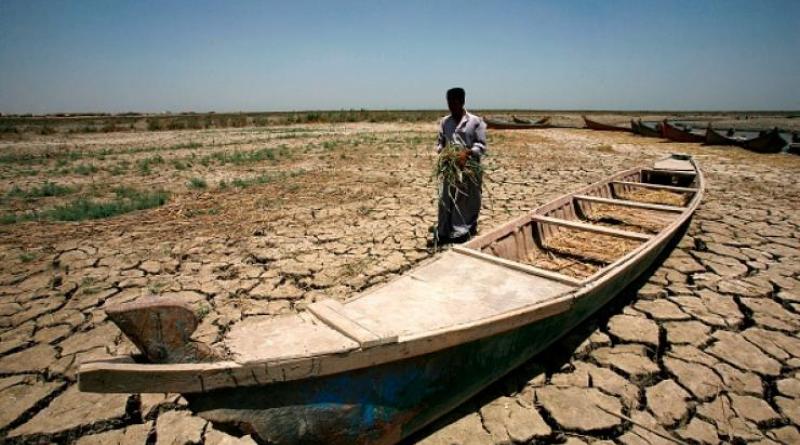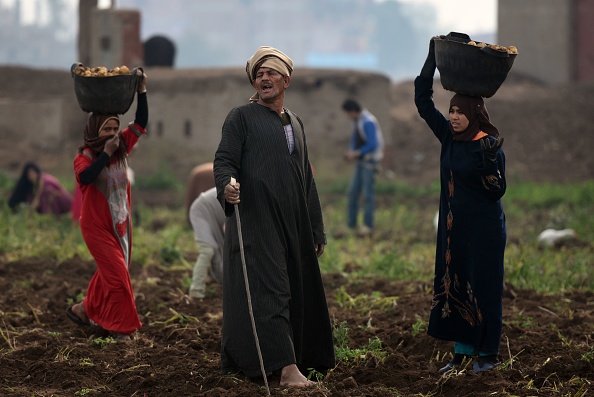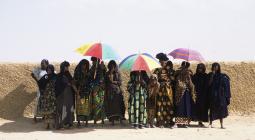Climate change, water woes, and conflict concerns in the middle east: a toxic mix.

Hotter heatwaves, higher sea levels and more severe droughts: This is the sweltering reality in Middle East and North Africa (MENA) where climate change is an especially urgent issue. By 2030, temperatures in the world’s hottest, driest and most water-scarce region are expected to increase more than twice the global average. Given the combination of structural fragilities, civil wars, and poverty, the impact of the region’s susceptibility to some of the most severe consequences of global warming on real people’s lives are far-reaching.
Why Is the Middle East So Vulnerable?
Climate change is the long-term alteration of temperature and typical weather patterns in a place. The climate of an area includes seasonal temperature and rainfall averages, and wind patterns. Different places have different climates. A desert, for example, is referred to as an arid climate because little water falls, as rain or snow, during the year. Other types of climate include tropical climates, which are hot and humid, and temperate climates, which have warm summers and cooler winters.
Professor Jos Lelieveld, of the Max-Plank Institute for Chemistry in Mainz and the Cyprus Institute Nicosia, Cyprus, explained to Majalla why the MENA region’s geological and ecological particularity makes it the most vulnerable to climate change: “In the subtropics, atmospheric circulations promote high temperatures and dryness. The lack of rainfall inhibits the presence of vegetation and soil moisture. In temperate regions, for example, warming can be counteracted by enhanced evaporation over land. In the mostly cloudless Middle East, atmospheric mechanisms that temper climate change are weak and can even amplify the warming. In addition, evaporation from the sea causes high humidity, but rain remains absent, which causes great discomfort, for example in the Gulf area,” he said.
While countries around the Gulf will be most strongly affected by heat extremes in summer, Prof. Lelieveld says that countries that presently still have rain and agriculture will suffer from increased droughts. In the entire region, however, “heat waves will become more extreme, with important consequences for public health,” he added.
Water Woes
The Middle East and North Africa has been experiencing almost continuous drought since 1998 – the most severe dry spell in 900 years according to NASA. According to the World Bank, the region is home to 6 percent of the world’s population, but only 1 percent of the world’s freshwater resources, with 17 countries in the region falling below the water poverty line set by the United Nations. With rainfall projected to decline 20 to 40 percent in a 2°C hotter world, and up to 60 percent in a 4°C hotter world, the region’s ability to provide water to its people and economies will be severely tested. It is expected that by 2025, 80-90 million people will be exposed to water stress. These worsening conditions will eventually make parts of the region uninhabitable. By 2100, “wet-bulb temperatures”—a measure of humidity and heat—could rise so high in the Gulf as to make it all but uninhabitable, according to a study in Nature.
Where Middle Easterners will still be able to live, the reduction in the availability of water will stoke tensions over diminishing resources. The United Nations has warned that swelling populations and food demands, combined with even scarcer water and land resources, could lead to a doubling of food prices as local crops will become depleted and farmers’ livelihoods blighted – triggering civil unrest in some developing countries.
Several countries are already experiencing instability connected to climate change-linked drought. An example of global warming’s damaging power is the war in Syria: “We have seen an example in Syria, where the rural population could not cope with the extended drought period since the end of the 1990s. By suppressing the protests and the demands for help in 2011, combined with the so-called “Arab spring”, the violence escalated,” said Prof. Lelieveld
The prolonged dry spell in the country led to the death of 85 percent of livestock in the east and widespread crop failure, pushing 800,000 people into food insecurity and triggering mass migration from rural to urban areas with farmers moving into urban centers like Damascus and Aleppo. From 2002 to 2010, the country’s total urban population increased by 50 percent, priming the populace for concentrated, large-scale political unrest.
“It was observed that displaced inhabitants of rural areas who went to seek employment in Syria’s larger cities, a large portion of which were already overpopulated, formed disenfranchised belts of disparate communities surrounding Hamah, Homs, and Daraa. This contributed ultimately to extreme political unrest outbreak of conflict in Syria, and followed by President Bashir al Assad use of his armed forces against them.” Jamal Saghir, a former World Bank director and currently professor at McGill University, told Majalla.
Climate-induced economic despair and migration also worked to grow the influence of ISIS in Syria. When ISIS controlled large swathes of territory across Iraq and Syria, it wrested control of dams that provided drinking water, electricity, and irrigation to millions along the Tigris and Euphrates rivers. “ISIS capitalised on the devastation brought by climate change to attract new members as it happened in several agricultural villages in Iraq, many of which were successfully taken by ISIS via their recruitment tactics that were created to entice impoverished farmers who had their lives and incomes devastated by a series of natural disasters, such as drought and harsh winds. These ISIS recruiters even offered money, food, and other riches to rural Iraqis to allure them into joining the ranks of the jihadist group,” Prof. Saghir said
Water-induced conflicts have broken out elsewhere in the region, too. “The fight over water supply in the basin of Jordan, Tigris-Euphrates, and the Nile Rivers one of the major conflicts in the region,” Rusul Al Shihab, director of Earth Day 2020 for the Middle East, told Majalla
In Jordan, one of the world’s most resource-poor states, many houses only get up to 24 hours of water a week. Protests broke out in the summer of 2018, the largest in recent years, over severe water shortages and food which led to the resignation of Prime Minister Hani al-Mulki. Another vulnerable water war hotspot is the Euphrates and Tigris river basin which flows through Turkey, Syria and Iraq. All three countries want to use as much water as possible for irrigation, and all three want to use the river flow for generating electricity.
The most prominent example of how the mere prospect of shortages can lead to conflicts is the Renaissance Dam project which has sparked a dispute over Ethiopia’s development needs, versus Egypt’s concerns over water scarcity and climate change. At present, unpredictable dry and wet weather in the Nile Basin — caused in part by climate change — is contributing to intermittent floods and water shortages. When Ethiopia started building an enormous dam on the Nile, potentially limiting the flow, Egypt, which relies on the river for nearly all of its water, threatened war.
Also threatening the Nile Delta, an area that makes up just 2% of Egypt’s total area, but is home to 41% of its population—roughly 100 million people – are rising sea levels. “The Nile-Delta is among the most threatened areas, with sea-level rise potentially displacing millions,” said Prof. Saghir.
All along the delta, the river banks are already eroding and much of the northern delta is gradually sinking into seawater, drowning rich agricultural land and communities. Researchers has estimated that if sea level rise, oil and gas drilling, and groundwater pumping continue unchecked, nearly 3,000 square kilometers of the delta will sink by 2100.
A report by the United Nations said that if Egypt’s agricultural sector could decrease by as much as 47 percent by 2060 as a result of groundwater being inundated by saltwater and hundreds of billions of Egyptian pounds, about two to six percent of future gross domestic product (GDP), could be lost from effects on water resources, agriculture, coastal resources, and tourism.”

With 70 percent of the MENA region’s agricultural production rain-fed, the sector is highly vulnerable to fluctuations in temperature and precipitation as a result of climate change, especially as agriculture employs more than 35 percent of the region’s population and contributes 13 percent to the region’s GDP vs the global average of 3.2 percent. The world’s top nine wheat importers are MENA countries. Yet, around 50 percent of regional wheat and barley, 40 percent of rice, and nearly 70 percent of maize for the region is met through imports.
“Although 30-35 percent of the Arab countries depend on imports, regulating water usage, reducing unnecessary consumption and eliminating water-waste could be the key factor to help agricultures stability and its communities in the region,” said Al Shihab.
“Some countries in the Middle East are politically unstable and do not support their citizens with the means to adapt to climate change, for example, by helping farmers to cope with droughts and by adjusting cities to manage the consequences of heat extremes,” he added.
Urgent vs Long-Range Threats
Syria, Libya, Yemen – with so many urgent issues in the Middle East, the region is distracted from the long-term threat of climate disruption. “With the political unrest and sectarian conflicts in many of MENA’s countries, attention on rescuing the environment and fighting climate change has shifted. Such a shift causes a weak waste management systems, scarce water resources, lack of afforestation, as well as an absence of environmental education and awareness.” Al Shihab.
Despite the enormous security threats facing the region, Prof. Lelieveld says that the acceptance of climate change as an important issue should be higher on the political agenda in the Middle East. “Political instability, poverty and climate change are a “toxic mixture for society, and the international community needs to help countries such as Syria, Libya and Yemen. Other countries in the Middle East need to realize that ignoring climate change will not make it go away, and actually the problems will accelerate in time, he said.
“With increasing heat extremes, and water and food supplies under threat, people need help from their governments. Improving water management, agricultural methods and city planning are already of high priority. Countries that neglect these needs face societal unrest, which will undermine national and regional security.”
“The dependence on fossil fuels needs to decrease. Improved awareness and adaptation measures are required. Investments in non-polluting and future-oriented technologies and agriculture, together with education will make societies more resilient,” he added.
Prof. Saghir says that “transformative” policies are needed in the Middle East to confront the new global climate reality and that in pursuing such policies, special attention needs to be given to “preventative measures that anticipate and mitigate exacerbated risks to avoid insecurity driven by food, water, and energy scarcities,” he said.
“The transition to a more energy and water secure and more diversified region, I think, is one of the most important ways that we can invest and seek advantages. Rather than focusing on the threats of climate change, this is an opportunity to use our climate awareness and our ability to innovate,” he added.
Once such opportunity lies in the Middle East’s abundance of sunshine. “The region has lots of sunlight, for example, which can be used to desalinate seawater and generate the energy needed to cool down in summer. Solar energy can be used to generate hydrogen, which could become the energy carrier of the future,” said Prof. Lelieveld.
8 September 2020
EARTH DAY 2020





